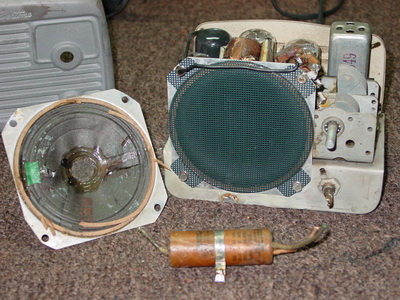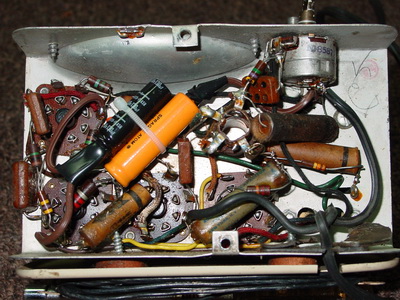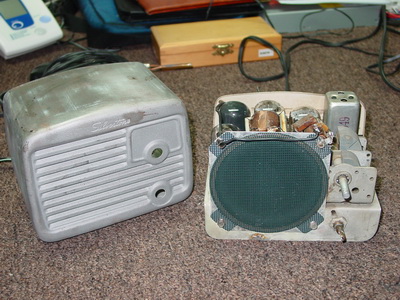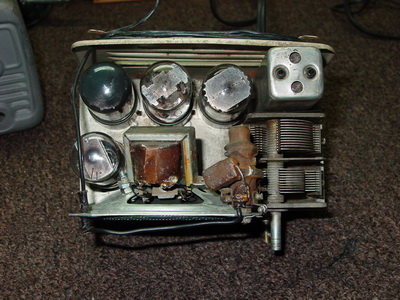One of my long-time interests is restoring old tube radios. This one is a Silvertone 6002 4-Tube AC-DC radio brought to the service bench by my brother. He has been pursuing restorations himself with growing success as he learns about electronics and about the older designs. This one was a challenge for him.

When I opened the radio the first thing I noticed was the nasty condition of the speaker (as shown above). It had several rips and the voice coil was rubbing on the magnet core. Even if the cone was repaired this speaker was going to sound horrible. What were the chances I had a 4 inch speaker in my junk box? What do you know? Not only did I have one but it had this nice custom screen rivited to the front. I decided to leave it to protect the new speaker from careless technicians.
Before I powered up the radio I examined the design. These transformerless radios are very deadly. Sometimes one side of the AC line cord is directly connected to the radio's chassis. Depending on how it is plugged into the wall the radio chassis could be "live" and you could get electrocuted if you touch it while you are touching something grounded like a water fawcet or standing on the floor with something other than sneekers. This radio was a little safer with the internal ground floating but decoupled to the chassis through a .1mf capacitor. This is still enough to give you a zap under certain conditions.
Powering up the radio caused the tubes to light and then the radio delivered a loud hum. This is usually caused by one or more failed capacitors in the power supply. Sure enough, after replacing the multi-section capacitor (shown above) with three individual capacitors of the same values the radio came to a meager life.

In this bottom view you can see two of the new filter capacitors (black and yellow).

This radio is NOT an All-American Five. It is an "Almost-American Four" (my name). The tube line up is 12SA7 (Mixer/IF Amp), 12SQ7 (Detector and Audio pre-Amp), 50L6 (Audio Power Amp) and 35Z5 (Rectifier). There is only one RF amplifier tube in this radio so it is not sensitive at all. Even with the antenna wire stretched all the way out the radio barely receives the 50kw local station 10 miles away!
My brother stripped the metal cabinet down to the bare metal for eventual re-painting. This radio was manufactured around 1946.

In this top view you can see the audio output transformer mounted to the speaker. The old speaker had a mounting bracket spot-welded to the speaker frame. The new speaker did not have the bracket so I had to improvise. I uses a 6-32 stud with several nuts to make a stand-off to mount one end of the transformer to the speaker frame. It's not the prettiest but it's not that bad either.
Notice there is only one IF transformer. The antenna coil is mounted to the top of the speaker right next to the tunning capacitor. The back of the radio has a place for the extendable antenna wire to coil up around the back plate. With the antenna coiled up the radio hears nothing!
This was certainly an interesting restoration project. It was not all that rewarding because of the poor performance of the radio by design.



